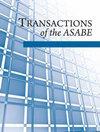Nitrous Oxide and Methane Emissions from Beef Cattle Feedyard Pens Following Large Rainfall Events
IF 1.4
4区 农林科学
Q3 AGRICULTURAL ENGINEERING
引用次数: 1
Abstract
HighlightsNitrous oxide and methane emissions were measured from a commercial beef feedyard following large rainfall events.Nitrous oxide emissions dropped below detection levels for ten days following a 77 mm rainfall event.Daily N2O and CH4 emissions followed a diel pattern, peaking at manure temperatures of 36°C to 38°C.Results will be used to refine empirical models for predicting GHG emissions from open-lot feedyards.Abstract. More than six million beef cattle are fed annually in feedyards on the semiarid Southern Great Plains (SGP). Manure deposited on the open-lot pen surfaces contributes to greenhouse gas (GHG) emissions. Nitrous oxide (N2O) and methane (CH4) are GHGs linked to climate change, and both have global warming potentials greater than carbon dioxide (CO2). Two sampling campaigns were conducted in 2019 to quantify N2O and CH4 emissions from open-lot pen surfaces. The occurrence of large, unforecast rainfall events during both campaigns provided an opportunity to compare GHG emissions from the dry manure before rainfall and from the wetted pen surface for one to two weeks following precipitation. Temporal variability was quantified by continuous sampling using six to eight automated flux chambers, a multiplexer system, and real-time analyzers. Spatial variability was quantified using a recirculating portable chamber on a 5 × 8 grid. Nitrous oxide emissions dropped below detection levels for ten days after the precipitation event. Nitrous oxide emissions were related to nitrification or other aerobic processes. Methane emissions dropped below detection levels for five days after the precipitation event and then increased to pre-rainfall levels by day 8. When present, N2O and CH4 emissions followed a diel pattern, with the highest emissions occurring during the afternoon when manure pack temperatures at the 25 mm depth were 36°C to 38°C and ambient temperatures were 31°C to 32°C. Average CH4 emissions from the feedyard pen surface were 96-fold lower than estimated enteric CH4 emissions. The results of this field research will be used to refine empirical models for predicting annual N2O and CH4 emissions from open-lot beef cattle feedyards on the semiarid SGP. Keywords: Beef cattle, Flux chamber, Greenhouse gas, Manure, Nitrous oxide, Rainfall.大降雨后肉牛饲养场围栏的氧化亚氮和甲烷排放
在大降雨事件发生后,测量了商业牛肉饲养场的氧化亚氮和甲烷排放量。在一场77毫米的降雨后,一氧化二氮的排放量连续10天低于检测水平。日N2O和CH4排放量呈日增模式,在粪便温度为36 ~ 38℃时达到峰值。研究结果将用于改进预测露天饲料场温室气体排放的经验模型。在半干旱的南部大平原(SGP),每年有600多万头肉牛被饲养在饲养场里。露天猪圈表面的粪便会导致温室气体排放。一氧化二氮(N2O)和甲烷(CH4)是与气候变化有关的温室气体,两者的全球变暖潜能值都大于二氧化碳(CO2)。2019年进行了两次采样活动,以量化露天围栏表面的N2O和CH4排放。在这两次运动期间,发生了大规模的、不可预测的降雨事件,这为比较降雨前干粪肥和降雨后一至两周内湿润的围栏表面的温室气体排放提供了机会。通过使用6至8个自动通量室、多路复用系统和实时分析仪进行连续采样,对时间变异性进行量化。在5 × 8网格上使用循环便携室对空间变异性进行量化。在降水事件发生后的10天内,一氧化二氮的排放量降至检测水平以下。氧化亚氮的排放与硝化或其他有氧过程有关。降水事件发生后第5天,甲烷排放量降至探测水平以下,第8天又回升至降雨前水平。当存在时,N2O和CH4的排放呈日增模式,在25 mm深度的粪堆温度为36°C至38°C,环境温度为31°C至32°C的下午排放最高。饲料场围栏表面的平均CH4排放量比估计的肠道CH4排放量低96倍。本研究结果将用于改进半干旱SGP上露天肉牛饲养场N2O和CH4年排放预测的经验模型。关键词:肉牛,通量室,温室气体,粪便,氧化亚氮,降雨
本文章由计算机程序翻译,如有差异,请以英文原文为准。
求助全文
约1分钟内获得全文
求助全文
来源期刊

Transactions of the ASABE
AGRICULTURAL ENGINEERING-
CiteScore
2.30
自引率
0.00%
发文量
0
审稿时长
6 months
期刊介绍:
This peer-reviewed journal publishes research that advances the engineering of agricultural, food, and biological systems. Submissions must include original data, analysis or design, or synthesis of existing information; research information for the improvement of education, design, construction, or manufacturing practice; or significant and convincing evidence that confirms and strengthens the findings of others or that revises ideas or challenges accepted theory.
 求助内容:
求助内容: 应助结果提醒方式:
应助结果提醒方式:


